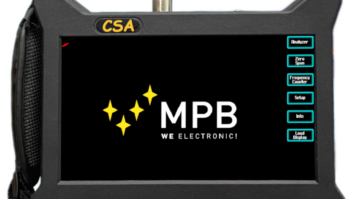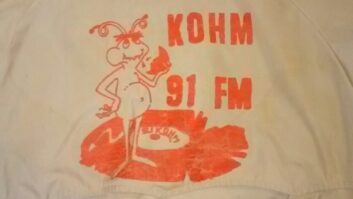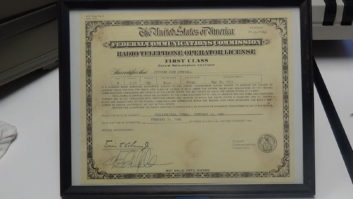
Image from a YouTube video of AM reception using SpectraVue.
More Memories of Catalina’s KBRT(AM)
Thanks for the great Scott Fybush article on the Catalina Island 740 AM facility and its history (“One of America’s Most Remote AM Sites Signs Off,” Jan. 16). I feel compelled to provide a few additions and clarifications to his story.
I have stood in both KBIG/KBRT(AM) and KMEO(AM) in Phoenix at sign-off and have had KCBS(AM) come in with such clarity on the studio monitors the moment the local carrier was silenced, it was easy to think the station had simply changed formats (not signed off).
I had the opportunity to visit the Catalina transmitter site on more than one occasion in the early part of the 1970s, accompanying the engineer on his weekly run. We’d drive down from the KBIG studios on Sunset Boulevard over to the San Pedro area, fly over on a Grumman Goose seaplane and then jump into the station Jeep kept in Avalon.
The KBIG staff’s emphasis was on AM. They considered FM as nothing more than a big automation system in the back room that depended on someone remembering to change reels occasionally. The AM station, meanwhile, was generating revenue by doing such specialty programming as covering Mexican road races and whatever else would attract a sponsorship.
After our dramatic success at co-owned WRFM(FM) in New York, in 1970, Bonneville President Arch Madsen deemed that all of the remaining six company FM stations would transition to the musical format that I had brought to WRFM.
Since this required the packaging of our music on reels and the assembly of instructional materials and guidelines for creating the complete on-air product, it was decided that we should offer these services to stations in other markets as well, and Bonneville Broadcast Consultants was established as a separate division.
I went to Los Angeles in July 1971 to launch the programming on KBIG(FM) and re-focus the staff’s attention to the FM side. On nothing more than word of mouth, the station’s popularity and ratings began to soar … and the AM from Catalina finally became the “stepchild,” although I don’t remember what it actually aired over the next couple of years.
However, later in the 1970s, it began offering a brighter, more vocals-oriented version of the FM’s easy-listening format. At that time, the call letters were changed to KBRT and the stations were promoted as the “Big & Bright” duo.
Marlin R. Taylor
Program Director
Sirius XM Radio
Silver Spring, Md.
A Recommendation for Spectrum Analysis
I read “IBOC at Night, Five Years Later” (March 1) with interest.
James O’Neal mentioned that he wishes he had a spectrum analyzer. I have a suggestion. I use an RFSpace SDR-IQ receiver connected to my computer using SpectraVue software. This gives me a very high performance radio that receives anywhere from tens of kilohertz to 30 MHz.
It can receive many different forms of modulation and has adjustable bandwidth. The beauty of this system is that it has a spectral display in the normal style plus a waterfall display.
That display is awesome. You can see the IBOC carriers and you can even immediately tell where the station has set their band pass filters.
This is such an awesome way to DX that it becomes addictive. To visit the manufacturer’s website, visit radioworld.com/links, where you can also find a link to a YouTube video of AM reception using SpectraVue. It is interesting that the foreign stations being displayed are running digital sidebands of some sort but are not limiting the analog bandwidth as we do on IBOC.
Hope this is useful to you.
Steve Minshall
Director of Engineering
KOSO, KJSN, KQOD
KMRQ, KFIV, KWSX
Clear Channel Communications
Modesto, Calif.
Ham Rift Still Rankles
I am disappointed that you actually chose to give more space in your opinion column to the rants of Burt Fisher. It is one thing for someone to spend their free time on a personal tirade and mission to rip on a hobby that they choose to voluntarily participate in. It’s another for a broadcast engineer who should be encouraging others to learn and better themselves.
I am not impressed by the attitude that Mr. Fisher has displayed. Rather than QSB, going QRT would better suit those of us who still care.
Allan A. Augustyn, W8FYZ
Director of Network Engineering
Radio Results Network
Escanaba, Mich.










